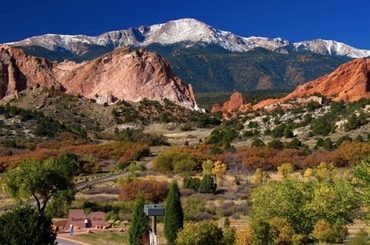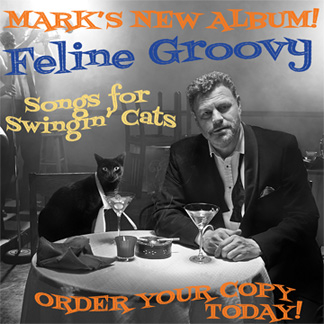To all our American readers, a happy Independence Day! This is, actually, the third Steyn's Song of the Week not merely of this week but of this day:
We began our Sunday with the flag-waver of all flag-wavers on the Glorious Fourth edition of The Mark Steyn Show.
Mark followed that with a great American song of contentment on his weekly Serenade Radio show. If you missed that, you can hear it repeated at 5.30am Monday London time - that's Sunday evening in North America, Monday afternoon Down Under.
And to round out this Glorious Fourth in not so glorious times, at a time when we dwell mostly on what is ugly in our society here is a hymn to beauty. This much requested essay is adapted from Mark's book A Song For The Season:
In 1893, a Massachusetts professor called Katharine Lee Bates was giving a series of summer lectures on English literature at Colorado College, in Colorado Springs. "One day," she recalled, "some of the other teachers and I decided to go on a trip to 14,000-foot Pikes Peak. We hired a prairie wagon. Near the top we had to leave the wagon and go the rest of the way on mules. I was very tired. But when I saw the view, I felt great joy. All the wonder of America seemed displayed there."
Professor Bates had not previously traveled in the Rockies or seen much of her country at all beyond New England, and the unbounded beauty of the land awed her - and inspired her. It was "the most glorious scenery I ever beheld, and I had seen the Alps and the Pyrenees," she said.
"My memory of that supreme day of our Colorado sojourn is fairly distinct even across the stretch of 35 crowded years," Miss Bates wrote a year before her death in 1929. "We stood at last on that Gate-of-Heaven summit, hallowed by the worship of perished races, and gazed in wordless rapture over the far expanse."
Though she insisted "the sublimity of the Rockies smote my pencil with despair", she was not "wordless" for long. "It was then and there, as I was looking out over the sea-like expanse of fertile country spreading away so far under those ample skies, that the opening lines of the hymn floated into my mind":
Oh beautiful for spacious skies
For amber waves of grain
For purple mountain majesties
Above the fruited plain!
She put them down on paper that evening in her room at the Antlers Hotel. Today you'd be hard put to find a quatrain known to more Americans. Whether it's Gary Larson's "Far Side" cartoon of Columbus approaching land and saying, "Look! Purple mountains! Spacious skies! ...Is someone writing this down?" or Rush Limbaugh at noon eastern welcoming listeners "across the fruited plain" to his daily radio show, every anchorman, cartoonist, comedian or advertising copywriter who evokes those words is assured that they're as instantly familiar to his audience as any lines ever written in American English.
Though they were born that day on Pikes Peak, they were not given to the world until the Fourth of July 1895, when they appeared in a weekly church publication in Boston called The Congregationalist. Whether or not Katharine Lee Bates could see actual amber waves or purple mountains in that thin air, she captured precisely the scale of America as no-one had done before: As the anonymous author of a long-ago booklet on patriotic music published by the John Hancock Insurance Company wrote: "Among our American songs, none surpasses in nationalistic idealism 'America, the Beautiful.' In it Katharine Lee Bates has caught the beauty, majesty, and immensity of this country of ours." The words have a humility before that beauty and majesty and immensity, yet they rise to the task and do them justice. In The Congregationalist, the editor's introductory note read:
Miss Bates's poem has the true patriotic ring pertinent to Fourth of July.
And over 125 Fourths later those words are not just the accompaniment to the celebration but part of the fabric and foundation of it. Here is the earliest recording I know, made in April 1924 by the Shannon Quartet - as in Irishmen; but, unlike a lot of Americans, the lads know more than merely the first verse:
You don't always hit the bullseye first time. In that original published version, the poet offered "halcyon skies", not spacious ones, and the plain was "enameled" - which, aside from anything else, doesn't sing as well, though at the time she had no idea anyone would want to sing it at all. "No one was more amazed than I at the way the hymn was taken up," the author explained to one audience. "When I found that you really wanted to sing it, I rewrote it in some respects to make it a bit more musical." And so the professor's vacation postcard became a great patriotic anthem:
America! America!
God shed His grace on thee
And crown thy good with brotherhood
From sea to shining sea!
Katharine Lee Bates was born on the shining sea, at Falmouth, Massachusetts in 1859, and graduated from Wellesley High School. In 1877, when she went on to Wellesley College, it was only two years old, and the campus in her words was "a paradise still fresh and wild". She stayed until 1925, when she retired as professor emeritus of English Literature. She had always loved her country but in those early years she hadn't seen a lot of it, only the non-spacious skies and the amber ripples of grain and the green-mountain below-the-tree-line majesties of New England. In 1893, Chicago hosted the World's Columbian Exposition (marking the quatercentenary, albeit a year late, of Columbus' discovery of the New World) and Miss Bates decided to go see it: The novelties on display included the first electric railway, the first "sliding fastener" (ie, a zipper) and a snack called "Cracker Jacks" (see our baseball season song). Among the other advertised highlights were both the real Liberty Bell and a replica constructed entirely from oranges, rivaled only by a map of the United States made out of pickles. The poet and teacher arrived in the city on July 1st, accompanied by her friend, Katharine Coman, a history professor and founder of Wellesley's Economics Department. They lived together in what was known as a "Boston marriage": Today, we carelessly assume the relationship must have been sexual, though most "Boston marriages" weren't; they were domestic arrangements which provided spinsters with companionship and greater economic security, and one should always be wary about imposing the mores of the present on the past. Whatever. The two Katharines were lifelong friends, and upon their arrival in Chicago they naturally stayed with Professor Coman's parents at the family home.
Unlike colonial Boston, the Windy City was new and modern and reaching as high as the purple mountains toward the spacious skies. You can hear something of Miss Bates' reaction to the urban energy of Chicago in the final verse of her poem:
Oh beautiful for patriot dream
That sees beyond the years
Thine alabaster cities gleam
Undimmed by human tears...
"America The Beautiful" is not a nostalgic evocation of a pastoral landscape but a paean to its potential, including the gleaming modernity of Chicago. Not everyone cared for the poem's view of the urban landscape: One hymnal editor from Rochester, New York demanded the author remove "alabaster" and substitute "some word or phrase more clearly significant of American ideals". But I like it, and it's hard to think of anything more idealistic when applied to the great teeming warrens of the metropolis. To Katharine, "alabaster" was meant very literally: The centerpiece of the Columbian Exposition was the "White City" of the future, fourteen blocks of architectural marvels with marble facades painted white, and shining even whiter in the nightly glow of thousands of electric lights. The Chicago fair set in motion urban improvement projects across the land. As Miss Bates wrote:
All men were poets for one brief, bright space
In the White City.
One way or another many of the patriotic underpinnings of 20th century America derive from the 1893 Exposition: the Pledge of Allegiance was written for it, and Columbus Day became a national holiday because of it. But its greatest gift to the nation was "America The Beautiful" - for without the fair in Chicago Katharine Lee Bates would never have set off on her great voyage of discovery. On July 3rd, the two Katharines caught the train to Colorado and the following day, Independence Day, she sat in the car and watched – what's the word? - waves of Kansas wheat rolling by. She was, she confided to her diary, "a better American for such a Fourth".
This Fourth of July, Americans will sing the first verse, which at most performances nowadays is all we hear. But Miss Bates had more to say than mere topographic description. "America" is a fusion of the beauty of the land with the glory of the idea. As she wrote in the second verse:
Oh beautiful for pilgrim feet
Whose stern, impassioned stress
A thoroughfare for freedom beat
Across the wilderness!
America! America!
God mend thine ev'ry flaw;
Confirm thy soul in self-control
Thy liberty in law...
Which is a more controversial notion in Massachusetts today than it was back then - that liberty operates best within self-imposed restraints.
As her poem's popularity spread and readers clamored to sing it, the author declared that, as long as you kept to her words, she didn't care what tune you sang it to. Silas G Pratt, who'd conducted some of the musical performances at the Exposition in 1893, was the first man to supply a melody for the words. But it wasn't good enough; it didn't rise to the level of the poetry. And so fans of the verses rummaged through their hymnals until, as was the practice in the 19th century, they found a tune that fit. Over 60 were pressed into service in "America The Beautiful"'s early years, including for a while "Auld Lang Syne", which works well enough. Delete:
Should auld acquaintance be forgot
And never brought to mind?
Should auld acquaintance be forgot
And days o' Auld Lang Syne?
Replace with:
Oh beautiful for spacious skies
For amber waves of grain
For purple mountain majesties
Above the fruited plain!
The marriage of words and music is a peculiar business. Nouns and verbs can sit on this or that combination of notes and function efficiently enough. But the right combination of the two elements is transformative. Ira Gershwin liked to cite the old Encyclopedia Britannica definition:
SONG is the joint art of words and music, two arts under emotional pressure coalescing into a third.
Not until Katharine Lee Bates' words met the right melody did they coalesce into a real song. The tune that stuck was by Sam Ward. Samuel A Ward descended from a long line of Sam Wards, including Sam Ward, the colonial governor of Rhode Island and representative to the Continental Congress. His forebear Roger Williams was the founder of Rhode Island, and his cousin Julia Ward Howe wrote "The Battle Hymn Of The Republic". Who better to compose a great patriotic anthem encompassing both the topographic and historic sweep of America?
But it didn't exactly happen like that. If the words of "America The Beautiful" were born atop Pikes Peak in the Rockies, which magnificent vista brought forth the music?
Answer: Coney Island.
Sam Ward was the organist at Grace Episcopal Church in Newark, New Jersey, and one weekend he and Harry Martin went to Coney. To eat baloney on a roll (as Lorenz Hart later wrote)? Well, we don't know how they passed the day, but Sam's son-in-law gave an account of how it ended, as Sam and Harry rode the sidewheeler back to Manhattan, and contemplated the Iron Tower and the beer gardens and all the other attractions receding into the distance:
'Harry,' he said to his friend, 'if I had something to write on I'd put down a tune that has just come to me.'
Harry dug in his pockets, he fumbled through his coat, his trousers, his vest, searching for some paper. Finding none, he took off a starched linen cuff and gave it to his friend who, leaning on the boat rail, drew a staff and clef and wrote the melody of 'America The Beautiful'.
Hmm. Whatever the truth of the starched-cuff stuff, the melody of "America The Beautiful" was first heard at Grace Episcopal Church sung by a 200-strong choir under the direction of Harry Martin. Only it wasn't "America The Beautiful" back then. After all, it was 1882, more than a decade before Katharine Lee Bates wrote her poem. As far as Sam Ward was concerned, his Coney melody was written to be sung to the hymn "O Mother Dear, Jerusalem". Go on, try it:
O Mother Dear, Jerusalem,
When shall I come to thee?
When shall my sorrows have an end,
Thy joys when shall I see?
O happy harbor of the saints!
O sweet and pleasant soil!
In thee no sorrow may be found,
No grief, no care, no toil!
It fits the meter of Sam Ward's tune, but not as well as Miss Bates' words. For example, you miss the internal rhyme of "crown thy good in brotherhood", which suits the melodic line so much better than the unrhymed "no sorrow may be found". And, compared to "O happy harbor of the saints", the repetition of "America, America" sings so naturally it's hard to believe the words and music weren't conceived together. In her marvelous book America The Beautiful: The Stirring True Story Behind Our Nation's Favorite Song, Lynn Sherr asked her friend Marvin Hamlisch, the composer of "The Way We Were" and the score of A Chorus Line, to sit down at the piano and take her through the tune. He made a very perceptive point:
He slid into the refrain, raising his voice with the high notes and belting out the words like a kid in the choir: 'A-MER-i...' Mid-syllable he stopped and turned to me excitedly. It's that climb up, that jump to 'America!' that gives you a feeling of reaching for something big. If this song were not about America, that's where you'd say 'I love you!' That's where you'd say 'I need you!'
It doesn't have to be "big". You can sing those lines reflectively or contentedly: not all love songs are "big" and declarative. But Hamlisch is right: that's where you'd say "I love you". Perhaps that's why, of all the big patriotic songs, it's the one the guys in the love-song business love to sing: Sinatra, Elvis and, of course, Ray Charles, whose version is these days the single best-known recording. Ray liked to start with the third verse:
Oh beautiful for heroes proved
In liberating strife
Who more than self their country loved
And mercy more than life...
I'm not sure about opening with those lines. Miss Bates' poem proceeds in a very logical order: first, the beauty of the land; then, the pilgrims who settled it; then, the heroes who fought for it. It's a compact history of America: a place, a people, an idea. And I suspect the author would feel that, in monkeying with the order, Ray discombobulates that a little.
But hey, who cares what I think? Frank's on board with Ray's version. Here he is at the second Reagan inaugural, just thirty-six years ago, but back when the cultural commissars still permitted A-list celebrities to sing in the presence of Republican presidents:
As I said, Miss Bates was fussy about the words, at least in English. But, as the song rippled its way around the globe, other peoples picked it up and somewhat clumsily applied its sentiments to their own lands. If you're worried about illegal immigration and La Raza and the re-annexation of the south-western United States by Mexico, well, at least the patriotic songs won't have to change. This is how "America The Beautiful" sounds south of the border:
Mi Mexico! Mi Mexico!
Bendigate el senor
Su gracia de haasta rebosar
Del uno al otro mar...
But that's not a thought on which to end a consideration of an all-time great Fourth of July song. Sam Ward never knew how enduringly popular his tune would be: he died in 1903. He never even met Katharine Lee Bates. Their writing partnership was involuntary and their respective contributions separated by eleven years, but, on their one collaboration together, they made a perfect songwriting team. For what could be a better summation of the nation than a patriotic anthem born in the majestic sweep of the Rockies and over the steaming hot dogs of Coney Island?
America! America!
God shed His grace on thee
And crown thy good with brotherhood
From sea to shining sea!
Happy Independence Day!
~The above essay is drawn from A Song For The Season, personally autographed copies of which are exclusively available from the Steyn store - and if you're a member of The Mark Steyn Club don't forget to enter your Club promo code for special member pricing.
As mentioned above, if you enjoy our Sunday Song of the Week, we have an audio companion, every week on Serenade Radio in the UK. You can listen to the show from anywhere on the planet by clicking the button in the top right corner here. It airs thrice a week:
5.30pm Sunday London (12.30pm New York)
5.30am Monday London (2.30pm Sydney)
9pm Thursday London (1pm Los Angeles)
Among the other perks of the Steyn Club is that members also get to hit the comments section below. So, if you prefer "God Bless America" or "My Country, 'Tis of Thee" - or even "O Canada" - to the above, feel free to make your case below. For more on The Mark Steyn Club, see here.






















